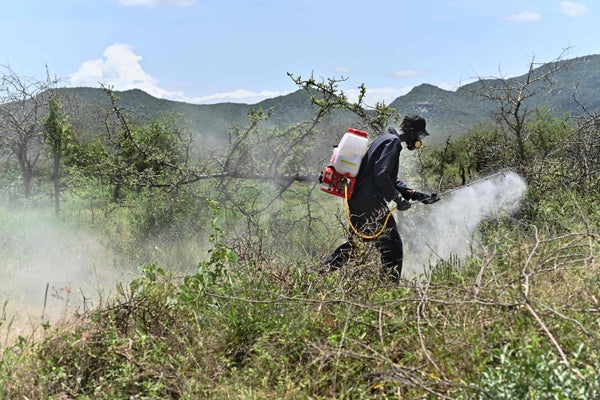U.N. officials say record numbers of desert locust swarms have spread from the Horn of Africa to the Persian Gulf region—despite efforts to contain the infestation through mass chemical spraying.
As worrisome is that new swarms have been detected in the African countries where the outbreak originated.
“The situation remains extremely alarming in the Horn of Africa, specifically Kenya, Ethiopia and Somalia where widespread breeding is in progress and new swarms are starting to form,” the U.N. Food and Agriculture Organization (FAO) declared in an update Monday.
On supporting science journalism
If you're enjoying this article, consider supporting our award-winning journalism by subscribing. By purchasing a subscription you are helping to ensure the future of impactful stories about the discoveries and ideas shaping our world today.
The ongoing spread of locusts in the region represents “an unprecedented threat to food security and livelihoods at the beginning of the upcoming cropping season,” U.N. officials said.
The outbreak was initially confined mainly to Kenya, Ethiopia and Somalia, but FAO says it’s now tracking 15 countries in Africa, the Middle East and South Asia affected by the locusts. The swarms have appeared in a swath hundreds of miles wide, from South Sudan in the west to parts of Pakistan in the east.
U.N. officials say the current locust infestation is the worst they’ve seen in 25 years.
FAO and other agencies have been mobilizing funds to help pay for government response efforts. The main tool used to tackle the infestation has been mass spraying of chemical pesticides from aircraft or on the ground—raising concerns over long-term environmental and health impacts.
FAO officer Keith Cressman says these worries are overblown and that his agency is taking every precaution to protect human health and the environment during the mass spraying campaign.
“Ecological damage is highly unlikely to occur as a result of desert locust control operations,” Cressman told E&E News. “Spraying involves precision spraying of only the insect and not spraying crops, grasslands or the environment, [and] infestations are not repeatedly sprayed.”
He added that only chemicals allowed for use in the European Union and United States are being employed to control the locust outbreak, and only after an independent advisory has reviewed and approved the use of specific chemical compounds.
Farmers and pastoralists also are told ahead of time when a spray operation is about to occur and are advised to keep themselves and their animals away from the area for at least 24 hours.
“Chemicals used break down after 24 hours under environmental conditions,” Cressman explained. “Furthermore, only well-trained and equipped national government teams with all safety precautions carry out the control operations, and not farmers or communities.”
FAO and U.N. Secretary-General António Guterres have pointed to climate change as an underpinning factor in the locust outbreak.
A harsh dry spell in the region was interrupted by two powerful cyclones toward the end of last year—a weather pattern that is unusual. The suddenly soaked conditions proved ideal for the breeding and growth of desert locust swarms.
Reprinted from Climatewire with permission from E&E News. E&E provides daily coverage of essential energy and environmental news at www.eenews.net.
